May 15, 2019 by Klaus Crow
Photo by Bigstock photo
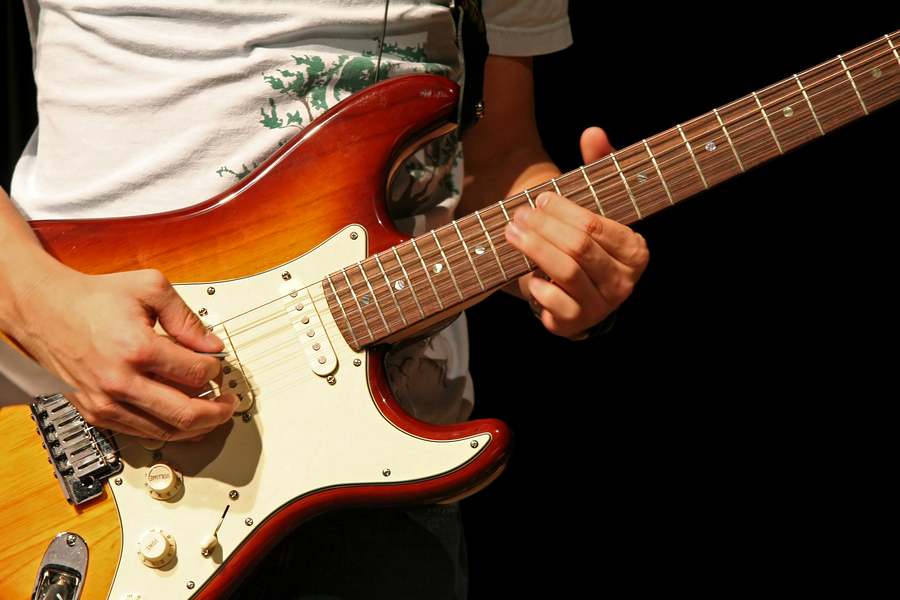
Later the technique was further developed by fusion guitarist Frank Gambale.
The quality of sweep picking is that it produces a fast and fluid sound (once you get the hang of it). This is because you only need few strokes as apposed to alternate picking.
While it is generally used for arpeggios, it can also be applied to scales, 3 notes per string licks and… well just anything really.
In this topic we’ll be covering 5 pentatonic patterns in the key of A. If you already know how to play the 5 pentatonic shapes using alternate picking and you want to try sweep picking for a change to make it sound more fluid, give it a more Gambale feel to it or just to see where it will take you, this one’s for you.
You don’t have to choose one picking technique for your style of playing. A lot of guitar players combine both. They use alternate picking mainly and apply sweep picking occasionally for particular licks or arpeggios.
Sweeping
For the alternate picking approach you go “down, up, down, up, down, up” with the picking hand. In the scale patterns below you also use alternate picking except when changing strings you’ll be picking in the direction of where you’re heading. Use a downstroke if you’re changing to a higher (pitch) string and use an upstroke if you’re changing to a lower (pitch) string.
You can see the down and upstroke symbols in the scale patterns right between the standard and tablature notation. The downstroke symbol looks like a hurdle for track and field, the upstroke symbol looks like a “V”.
I have to admit the pentatonic patterns are quite a stretch. Major scales are much easier to play, but for the rock and blues players out there we don’t want to miss out on the pentatonic.
It takes a bit of practice to get used to the sweep picking feeling but hang in there. After a while it feels so natural and easy. It’s the path of least resistance.
Have fun!
Pattern 1 (A minor pentatonic)
All 5 patterns are in the key of A, so the root note is also an “A” note.
Root notes are the “5” on the 6th string, the “7” on the 4th string and the “10” on the 2nd string.
Pattern 2 (A minor pentatonic)
Root notes are the “7” on the 4th string and the “10” on the 2nd string.
Pattern 3 (A minor pentatonic)
Root notes are the “12” on the 5th string and the “10” on the 2nd string.
Pattern 4 (A minor pentatonic)
Root notes are the “17” on the 6th string and the “14” on the 3rd string.
Pattern 5 (A minor pentatonic)
Root notes are the “5” on the 6th string, the “7” on the 4th string and the “5” on the 1st string.
If you really want to get into the sweep picking zone there’s a really cool Frank Gambale Sweep picking DVD called Monster Licks-Speed Picking
Keep on picking!
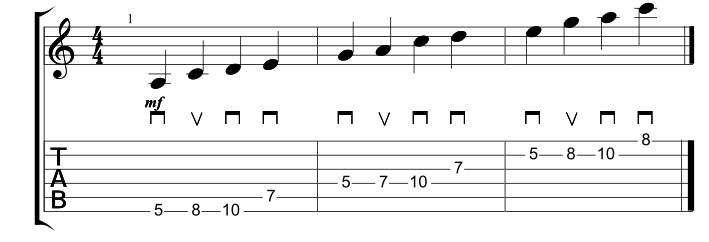

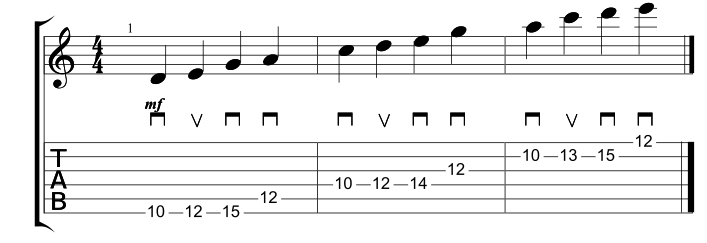
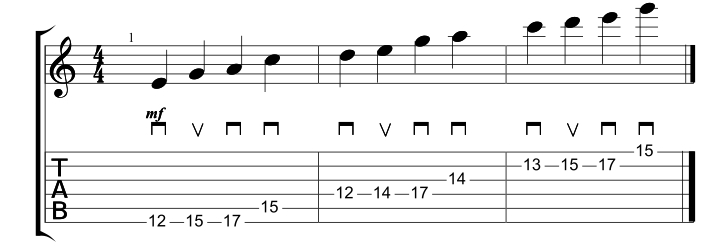
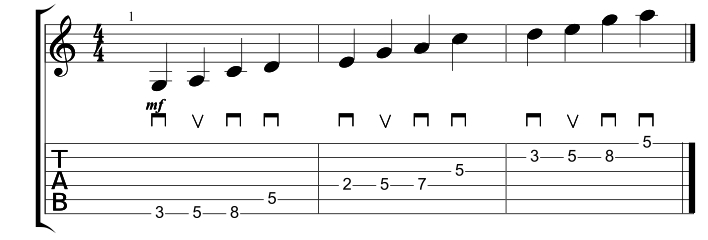
Hi Klaus,
Since it is in tablature it is easy to read. I am going to work these exercises.This “sweep picking” technique is a new term to me.
Thanks for sharing.
Hi Prasana,
Have fun with the patterns. First practice slow, memorize the pattern and when you feel comfortable gradually speed up.
Best regards,
Klaus Crow
Thanks as always Klaus. Looks interesting — look forward to getting to this lesson but I have a few Klaus lessons lined up before this one. You’re terrific. Keep up the great work — and a big thank you for all you do. -Alex
Hi Alex,
Take your time with the lessons. We have all the time in the world. Just enjoy whatever you’re practicing.
And thank you for keep hanging around.
Keep in touch!
Best regards,
Klaus Crow
This is Ahmed.
I hope you’re doing fine.
I’d love to hear your opinion on the best way to learn the guitar. I’m doing a roundup of opinions on my blog (where I ask 20 expert guitar players about the best way to learn the guitar) and i think people would love to hear what you (as an expert guitar player) think about.
Question: If you could suggest the best way to learn the guitar what would it be?
Of course, I’ll include a link back to your site (with a photo).
Thank you in advance.
Hi sir
I’m 60 years old man, after up and down in life I’ve given what I’d known and learned, since the recession I decided to pick up the guitar and learn a few notes strum a few chords singing a nonsence song,since that my life has changed I become better person I’d quit drinking quit smoking quit gambling ,,,there are many choices on you tube to learn guitar lesson..
but every time I hit the wall,your site help inspires teach, gives advice,not only in guitar also in mankind and You are also very generous You never once mentioned any buy and sell,,that make You a very special person a truly master.
.Learning guitar for me is not to become a rock star ,but to survive through the journey,,soon Ill become a homeless ,I’ll use my guitar skill to make a few bucks here and there on the street Your teaching ‘s very precious and valuable to me and I can’t thanks You enough.
best regard
Sam
Hi Klaus, I’m a rookie just started a few months ago. What I noticed in your examples here are that these are “3 notes per string patterns (basically), versus what I’ve seen else where. I’m more into BLUES of any type and what I’m learning is the Minor Pentatonic scales are very important. I’m currently practicing 2 NOTES per string. What kind of advice would you offer regarding the differences between the 2 NOTE versions and the 3 NOTE versions. I’m thinking about progressions as might be used in soloing using FINGER_PICKING techniques. Thanks Ron
Thanks for these.
I was learning a slightly different layout and now im torn which to commit to.
Is the 3 1 3 only useful for a full
On sweep or do you use it as a shell and add the other notes back to the strings with only 1 note for different phrasing capability?